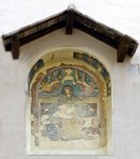

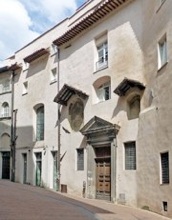
The Confraternita di Santa Maria della Misericordia, which administered this hospice was formed in ca. 1300 to care for those who were too poor to pay for medical help and for abandoned children. It received official approval from Bishop Bulgaro da Montemelino to establish this hospice in 1305, and the adjacent church was consecrated to the Santi Innocenti. The confraternity was decimated during the plague of 1348 and reconstituted in 1396, when the Commune reformed its constitution.
The charitable donations that the confraternity attracted enabled it to invest in property in the vicinity, which accounts for the ubiquitous trigrams on the buildings on each side of the street. Pope Nicholas V conceded the right to build along the parapet of the Piazza del Sopramuro to confraternity in 1453. They commissioned the Lombard architect commissioned Gasparino di Antonio and the Perugian Bartolomeo di Mattioli di Torgiano to build an arcade of shops. The latter artist was employed again to execute the vaulting in 1468-9. The Palazzo dell'Università (later Palazzo dell'Università Vecchia) was built above this arcade in 1490.
The church of Santa Maria della Misericordia took over the role of two nearby parish churches:
-
✴It took over SS Donato e Arrigo, a little further along Via Oberdan, in 1402, and its high altar received this dedication at that point. (This church closed in 1542 and later re-opened as San Giuseppe).
-
✴It absorbed the parish Santa Lucia di Colle Landone when that church (which stood on what is now the site of Palazzo Donini) was demolished to make way for Rocca Paolina in ca. 1540.
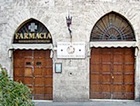
In 1737, the hospital received the property owned by the hospice of the Oratorio di Sant’ Antonio Abate. It also absorbed the hospital next to San Crispino, which was used as a mental hospital until 1823.
The church of Santa Maria della Misericordia was virtually rebuilt by Pietro Carattoli in 1760.
The hospital expanded over the centuries along what is now Via Oberdan, reaching the ex-Chiesa di San Giuseppe in 1833. It survived until 1923, when it was incorporated into the modern hospital that was built in the ex-Monastero di Santa Maria di Monteluce. The church was de-consecrated at that point. It has recently been restored and now houses an art gallery.
Facade
The facade reveals the fact that the original church was rebuilt (in 1760) on the foundations of the original, which had become exposed in 1581 when the level of the street in front of it had been significantly lowered. The arch of the original red and white stone portal (1305) can be seen above the present portal (below).
Madonna and Angels (early 14th century)
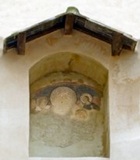
Santa Maria della Misericordia (1520)
Portal (1760)
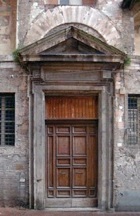
Interior
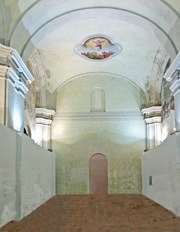
The restoration of the interior has revealed the clean lines of the rebuilt church.
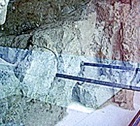
Frescoes (18th century)
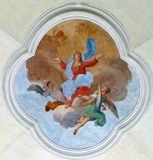
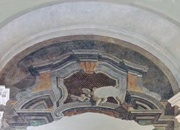
Some of the frescoes on the ceiling and the upper part of the walls survive.
Art from the Church
Processional Crucifix (ca. 1272)
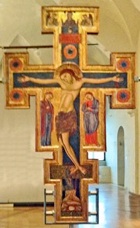
Each side depicts the suffering Christ on the cross, with the Virgin and St John the Evangelist to the sides. There are however differences in the upper and lower panels:
-
✴One side has an inscription HIC NAZARENUS; REX IUDEORUM; REX GL]ORIA]E in the upper panel, while the lower panel is blank.
-
✴On the other side (illustrated here), both panels are painted:
-
•the upper panel contains a small half-length figure of the praying Virgin between angels, above a smaller copy if the above inscription; and
-
•the lower panel contains a small kneeling figure of St Francis kissing the right foot of Christ. This figure was over-painted at some point to remove a small identifying inscription and the Franciscan habit, but these original features were revealed in a recent restoration.
Madonna and Child (ca. 1310)
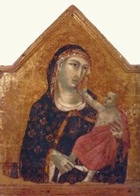
Work by Pellegrino di Giovanni (1434)
The documented work carried out for the Ospedale di Santa Maria della Misericordia by Pellegrino di Giovanni in 1434 no longer survives.
Madonna del Libro (ca. 1510)
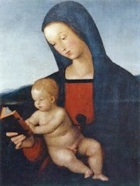
Adoration of the Magi (1538)
This damaged detached fresco, which is attributed to Sinibaldo Ibi and used to be dated by an inscription, was transferred from the Ospedale di Santa Maria della Misericordia to the Galleria Nazionale in 1879.
Coronation of the Virgin and saints (1611)
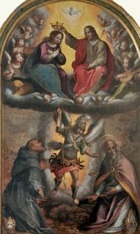
-
✴the Coronation of the Virgin, above; and
-
✴SS Francis, Micael Archangel and Blaise (the patron of wool workers) below.
It passed to the Ospedale di Santa Maria della Misericordia early in the 20th century and is now in the new hospital at Sant’ Andrea delle Fratte, outside Perugia.
Annunciation (1634)
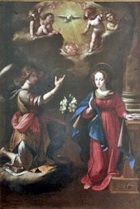
See also: Other Hospices and Hospitals of Perugia.
Return to Monuments of Perugia.
Return to Walk II.
